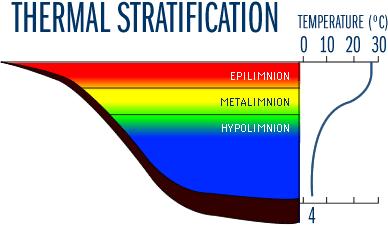The thermocline: a summer phenomenon in Michigan inland lakes
Understand why the lake is warm at the surface but cold down deeper.
Swimmers on inland lakes may notice a fairly dramatic change in water temperature when swimming in lakes deep enough to produce what limnologists call a thermocline. The thermocline is defined as the “depth at which the temperature gradient is steepest during the summer; usually this gradient must be at least 1 degree Celsius per meter of depth” according to the University of Minnesota’s Water on the Web. But how do thermoclines form?
Michigan lakes are usually dimictic in their seasonal patterns – meaning they mix twice a year. Lakefront property owners are familiar with what many describe as spring or fall “turnover.” At these times the temperature and density of lake water are so similar from top to bottom that winds blowing over the surface can actually cause a vertical mixing of the entire lake. In the fall, mixing continues until in the lake temperature drops below 4 degrees Celsius. In the spring mixing continues until the lake warms above 4 degrees Celsius and begins to stratify, forming a thermocline.
The thermal stratification process begins with longer, sunny days warming the surface waters of the lake. Warm water is less dense and lighter than cold water and so warming surface waters begin to form a layer at the top. With decreasing summer winds and increasing sunshine, the warm layer deepens but the lake can no longer totally mix from top to bottom. The colder, deep water eventually becomes isolated from the warmer surface waters forming the hypolimnion. The warm layer at the top is the epilimnion. Between these two layers is a mid-temperature range layer known as the metalimnion and this is where the thermocline is located (notice the green line in figure 1). It is at this depth that the temperature change is most noticeable to swimmers.
Figure 1: Thermal stratification

Used with permission from Water on the Web, 2009.
www.waterontheweb.org; University of Minnesota-Duluth
Duluth, MN 55812
The depth of the thermocline depends on the depth of the lake and it’s orientation to prevailing winds. A shallow lake may not thermally stratify at all – especially if the maximum fetch (or longest uninterrupted distance across open water) is in line with prevailing winds. Such a lake may mix continually throughout the summer. Deeper lakes tend to experience a stronger, more stable thermal stratification that can last until fall turnover.
For those interested in reading more on how lakes work, please visit Water on the Web. Click on “lake ecology” under the tab entitled “Understanding."



 Print
Print Email
Email




